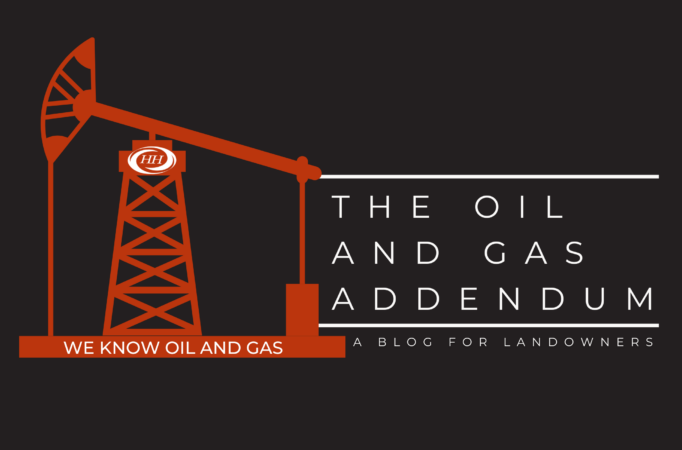The Oil and Gas Addendum
The Neale Rule – Who Really Owns the Oil and Gas Under Railroads?
Since the early 1900’s, your family has owned a 105 acre farm in Greene County, Pennsylvania. In 2024, you and your siblings sign an oil and gas lease with XYZ Drilling Company. The language in the lease states that it covers “that certain tract of land consisting of 105 acres, more or less . . . .” The lease also says that the signing bonus and all production royalties will be paid on “the net mineral acres” owned by your family. At the time, you and your siblings did not think much about these clauses as it was assumed the family owned all of the oil and gas under the 105 acre farm. About two months after signing the new lease, you receive a letter from XYZ Drilling, along with the signing bonus check. Much to your surprise, the check is less than what you expected. The letter states that due to “competing ownership interests”, the actual net mineral interest owned by the family is approximately 91 acres. You are confused, frustrated and concerned. Who else could possibly own the oil and gas under the family farm?
The letter informs you that Norfolk Southern Railway Corporation (“Norfolk Southern”) is asserting an ownership interest in the oil and gas formations under the rail line that runs through the western edge of the farm. The letter notes that a portion of the signing bonus (and future royalties) will be held in suspense until it is determined who actually owns the oil and gas under the railroad. The railroad has run through the farm for as long as you can remember. You do some research and discover an old deed from 1906 whereby your great-grandfather granted the Pennsylvania Railroad (“PRR”) an interest in a strip of land 150 feet wide for the purpose of constructing and operating a 4-gauge railroad (the “1906 Deed”). Can Norfolk Southern one hundred years later now assert an ownership interest in the oil and gas under that strip of land?
The short answer is “Maybe”. Many landowners across Pennsylvania are discovering that portions of their oil and gas holdings might be owned by railroad operators. As we have written before, confirming the ownership of oil and gas under streams and rivers, as well as roads and highways, can be complex and confusing. See, Pennsylvania Landowners May Not Own Oil and Gas Rights under Rivers and Streams (April 2016); The Strip and Gore Doctrine – Who Really Owns the Oil and Gas Under Roads and Highways (July 2023); The Centerline Presumption – Who Really Owns the Oil and Gas Under Roads and Highways (Part II) (February 2024). Questions regarding the ownership of oil and gas under railroads can be equally challenging. And peculiar rules, such as the Neale Rule, can create additional confusion for landowners.
By way of background, in the late 1800’s and early 1900’s, railroad right-of-ways in Pennsylvania were generally acquired in one of four ways: i) via grant from the United States government if the railroad was to pass through lands owned by the Federal Government; ii) via grant from the Commonwealth of Pennsylvania if the railroad was to pass through lands owned by the State; iii) via eminent domain or iv) via conveyance from a private landowner. Because the United States and the Commonwealth of Pennsylvania did not own significant areas of open land throughout the Commonwealth in the late 1800’s and early 1900’s, most, if not all, of the current railroad right-of-ways were likely acquired via eminent domain or through private conveyance. Under either scenario, the operative instrument was a deed from the landowner to the railroad. As such, the focus of this article will be an examination of those unique issues associated with ancient railroad deeds.[1]
Returning to our example, the salient question is whether the language in the 1906 Deed granted merely an easement in the strip of land or whether the 1906 Deed conveyed a fee interest in the land itself. But ancient railroad deeds are often inartfully drafted and frequently contain conflicting terms. For example, let’s assume that the granting clause[2] in the 1906 Deed contains the following language:
“WITNESSETH, that the said party of the first part, for and in consideration of One Dollar and other valuable consideration, does GRANT, BARGAIN and CONVEY unto the party of the secured part, and unto its successors and assigns, a right-of-way over and through that certain strip of land hereinafter described for the construction and operation of a railroad line across the following tract of land in Morris Township, Greene County . . . . . .”
The import of this language appears clear: the 1906 Deed was only granting an easement in the strip of land and nothing more. It is generally recognized that when a railroad deed contains nothing more than a grant of a right or privilege to “use” a certain strip of land, an easement is conveyed.
However, later in the 1906 Deed, the habendum clause describes the grant as: “To have and to hold said land, together with all appurtenances thereto belonging, in fee simple, unto the party of the second part, its successors and assigns, forever.” That language suggests more than an easement is being conveyed. As such, there is an inconsistency between the granting clause (i.e., grant of a right-of-way) with the habendum clause which purports to describe the conveyance of a fee simple interest. The distinction is significant. If the granting clause controls and only an easement was created by virtue of the 1906 Deed, then Norfolk Southern does not have a viable claim to the oil and gas under the strip of land. See, Brookbank v. Benedum–Trees Oil Co., 131 A.2d 103 (Pa. 1957)(holding that railroad did not acquire any ownership in the oil and gas since the 1903 deed only granted “a right to the surface and so much beneath as was necessary for the support of the railroad”); See also, Rio Bravo Oil Co. v. Hunt Petroleum Corp. 439 S.W. 2d 853 (Tex-App-Tyler 1969)(“. . . where the granting clause in a deed to railroad declares the purpose of a grant to be a right-of-way . . . it is a conveyance of a mere easement in the property . . .”). Conversely, if the habendum clause controls, then Norfolk Southern’s predecessor acquired complete ownership of the surface strip as well as the underlying oil and gas. See, Herr v. Herr, ___Pa. Super. ___(Pa. Super 2008)(a fee simple is “an interest in land . . . being the broadest property interest allowed by law . . . “). See also, Duquesne Natural Gas Co. v. Fefolt, 198 A.2d 608 (Pa. Super 1964)(“The right of property in natural gas and oil ordinarily belongs to the owner of the land”). Such inconsistencies are unfortunately common in ancient railroad deeds. What clause controls?
In resolving such inconsistencies, many courts often apply what is known as the “Neale Rule.” This rule is named after the Texas Supreme Court decision in Texas Electric Railroad Co. v. Neale, 252 S.W. 2d 451 (Tex. 1951). At issue in Neale was a railroad deed from 1912. The deed contained conflicting language and it was unclear whether the instrument created an easement or conveyed a fee simple interest in the land. The Texas Supreme Court resolved the inconsistency by adopting the following rule:
“[A] deed which by the terms of the granting clause grants, sells and conveys to the grantee a ‘right of way’ in or over a tract of land conveys only an easement . . . but a deed which in the granting clause grants, sells and conveys a tract or strip of land conveys the title in fee, even though in a subsequent clause or paragraph of the deed the land is referred to as a right-of-way . . .”
See, Neale, 252 S.W. 2d at 453. So, the Neale Rule basically says that the granting clause controls. In other words, if the granting clause refers to the conveyance as a “right-of-way”, then there is a presumption that only an easement was granted. And that description controls even though other portions of the deed may refer or suggest the conveyance of a fee interest. See, BNSF Railway Company v. Chevron Midcontinent, at al., 528 S.W. 3d 124 (Tex. App. – El Paso 2017) (“Neale established that in the presence of mixed deed language, it is the intent as conveyed by the granting clause that controls”). Pennsylvania appears to follow the rationale of the Neal Rule. In Fleck v. Universal Cyclops Steel Corp., 397 Pa. 648 (Pa. 1959), the Pennsylvania Supreme Court interpreted a 1885 railroad deed and opined that “. . . if and where the granting clause and the habendum clause of a deed are inconsistent, conflicting or repugnant, the granting clause must prevail.” Therefore, under Fleck, the language in a granting clause will generally control over inconsistent language found elsewhere in a railroad deed.
Back to Norfolk Southern. Since the granting clause in the 1906 Deed expressly describes and references a “right-of-way”, a strong argument could be made under Neale and Fleck that only an easement was granted in 1906. Given this conclusion, Norfolk Southern would have no colorable ownership interest in and to the oil and gas underlying the railroad. As such, XYZ Drilling should not be suspending any portion of the signing bonus as to the railroad tract.
If you have questions or concerns about the ownership of oil and gas under a railroad, please call Robert J. Burnett at (412) 281.5060 or email him at rburnett@hh-law.com.
[1] Ownership of the oil and gas underlying railroads acquired from the United States government is generally governed by the General Railroad Right-of-Way Act of 1875, 18 U.S.C. §492. See, Brandt Revocable Trust v. United States, 134 S. Cts. 1257 (2014)(the interest granted under the 1875 Act is an easement).
[2] The purpose of a granting clause in a deed “is to define and designate the estate conveyed” See, Richardson v. Mills, ____S.W.3d____ (Tex-App-Tyler 2017).
About Us
Oil and gas development can present unique and complex issues that can be intimidating and challenging. At Houston Harbaugh, P.C., our oil and gas practice is dedicated to protecting the interests of landowners and royalty owners. From new lease negotiations to title disputes to royalty litigation, we can help. Whether you have two acres in Washington County or 5,000 acres in Lycoming County, our dedication and commitment remains the same.
We Represent Landowners in All Aspects of Oil and Gas Law
The oil and gas attorneys at Houston Harbaugh have broad experience in a wide array of oil and gas matters, and they have made it their mission to protect and preserve the landowner’s interests in matters that include:
- New lease negotiations
- Pipeline right-of-way negotiations
- Surface access agreements
- Royalty audits
- Tax and estate planning
- Lease expiration claims
- Curative title litigation
- Water contamination claims

Robert Burnett - Practice Chair
Robert’s practice is exclusively devoted to the representation of landowners and royalty owners in oil and gas matters. Robert is the Chair of the Houston Harbaugh’s Oil & Gas Practice Group and represents landowners and royalty owners in a wide array of oil and gas matters throughout the Commonwealth of Pennsylvania. Robert assists landowners and royalty owners in the negotiation of new oil and gas leases as well as modifications to existing leases. Robert also negotiates surface use agreements and pipeline right-of-way agreements on behalf of landowners. Robert also advises and counsels clients on complex lease development and expiration issues, including the impact and effect of delay rental and shut-in clauses, as well as the implied covenants to develop and market oil and gas. Robert also represents landowners and royalty owners in disputes arising out of the calculation of production royalties and the deduction of post-production costs. Robert also assists landowners with oil and gas title issues and develops strategies to resolve and cure such title deficiencies. Robert also advises clients on the interplay between oil and gas leases and solar leases and assists clients throughout Pennsylvania in negotiating solar leases.

Brendan A. O'Donnell
Brendan O’Donnell is a highly qualified and experienced attorney in the Oil and Gas Law practice. He also practices in our Environmental and Energy Practice. Brendan represents landowners and royalty owners in a wide variety of matters, including litigation and trial work, and in the preparation and negotiation of:
- Leases
- Pipeline right of way agreements
- Surface use agreements
- Oil, gas and mineral conveyances

